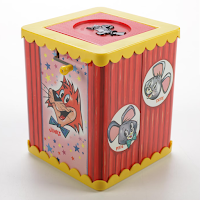 “The biggest show in town” debuted 64 years ago today.
“The biggest show in town” debuted 64 years ago today.
To the right are the TV listings in the Monday, Sept. 29, 1958 edition of the Kittanning (Pa.) Leader-Times. You can see Pittsburgh’s WTAE-TV, which had signed on only two weeks earlier, was one of the first stations to broadcast The Huckleberry Hound Show. WLW-I in Indianapolis was another. So was WOOD-TV in Grand Rapids, Michigan, which was picked up in Battle Creek, manufacturing home of Huck’s sponsor, Kellogg.
The cereal company bought the same time slot five nights a week, as it was also sponsoring The Woody Woodpecker Show, Superman and others aimed at kids. Who decided which shows would air on what nights is one of those mysteries lost in time, but an unofficial look at TV listings across the U.S. seems to indicate Thursday was a preference.
 The Chicago Tribune’s Larry Wolters was probably the first critic to rave about Huck on the basis of a preview (oh, to know more about that footage!), accurately predicting “Huck and his pals will prove a smash hit in television not only among children but adults as well.” You can read his full review in this old post. Two days later, the Napa Valley Register spoke of “good reports” about the show. And, if you’ve been around this blog long enough, you will have seen all kinds of newspaper clippings that teens and adults tuned in Huck, how he was a hit on college campuses, at least one bar told patrons to stop making noise while the show was on, how an Antarctic island was named for him, and so on. The show came away with an Emmy in 1960, and an animated Huck and Yogi appeared at the ceremony the following year in the first cartoon ever to be part of an Emmy broadcast.
The Chicago Tribune’s Larry Wolters was probably the first critic to rave about Huck on the basis of a preview (oh, to know more about that footage!), accurately predicting “Huck and his pals will prove a smash hit in television not only among children but adults as well.” You can read his full review in this old post. Two days later, the Napa Valley Register spoke of “good reports” about the show. And, if you’ve been around this blog long enough, you will have seen all kinds of newspaper clippings that teens and adults tuned in Huck, how he was a hit on college campuses, at least one bar told patrons to stop making noise while the show was on, how an Antarctic island was named for him, and so on. The show came away with an Emmy in 1960, and an animated Huck and Yogi appeared at the ceremony the following year in the first cartoon ever to be part of an Emmy broadcast.
Alas for gentle Huck, whose personality owes as much to Tex Avery’s Southern Wolf cartoons at MGM as anything, he was eclipsed by the more boisterous Yogi Bear. As you can see, one paper used a picture of Yogi in its ad for Huck’s debut in 1958. Another didn’t name any Huck cartoon, instead telling the viewers the initial show would feature Yogi Bear’s Big Break. In fact, Break was the first cartoon aired in the half-hour; Huck was saved until the last segment.
Newspaper ads featuring the characters are always fun. Here are a couple from, I think, 1961. Screen Gems’ promotional department put people in Huck and Yogi costumes in 1959 and sent them all over the U.S. Eventually, a stage show emceed by Eddie Alberian was developed for county fairs and other outdoor events. The second ad is from a time when Hanna-Barbera took up three of Kellogg’s five half-hours purchased as a strip on local stations. (The artwork omits the one other character that appeared in the Yogi cartoon—Yowp).


The Huck DVD purports to have episodes as originally broadcast. That’s not the case. The announcer who provided voice overs for Kellogg’s commercials in 1958 was Art Gilmore. You can hear him over the closing animation in the reconstructed first episode, but a different announcer in the opening, the one hired for the following season.
However, animation with Gilmore providing the opening has been discovered by collector Steven Hanson. While the documentation I have from the studio states that only one opening was animated, that’s clearly not the case as the original backgrounds (and sound effects) were different.
You can play the opening theme song (with no announcer) as you look at some comparisons from seasons one and two:








Gilmore’s voiceover pushes only one cereal: “Kellogg’s Corn Flakes, the ‘get going’ cereal, presents....” And the Randy Van Horne singers take it from there. There’s no “the best to you each morning” yet. That came a year later.
Ten years ago, in this post, we put up a version of Huck’s theme song as played, cha-cha style, by the Scarlet Combo, released in October 1961. It’s a band out of Louisville, fronted by a guy named Jimmy Wayne. Kenny Brookshire’s daughter says that’s her dad on sax and clarinet. Cashbox magazine rated it a “B”.
And finally something I would have liked as a kid—A Huck in a Box. (I had a Cecil in a Box). Huck is the familiar red colour that Knickerbocker liked using; Huck was only broadcast in black and white when this appeared in stores in 1959.



This post is dedicated to Huck fan Greg Chenoweth, our first reader, who dropped away when he moved from Everett, Washington.






































